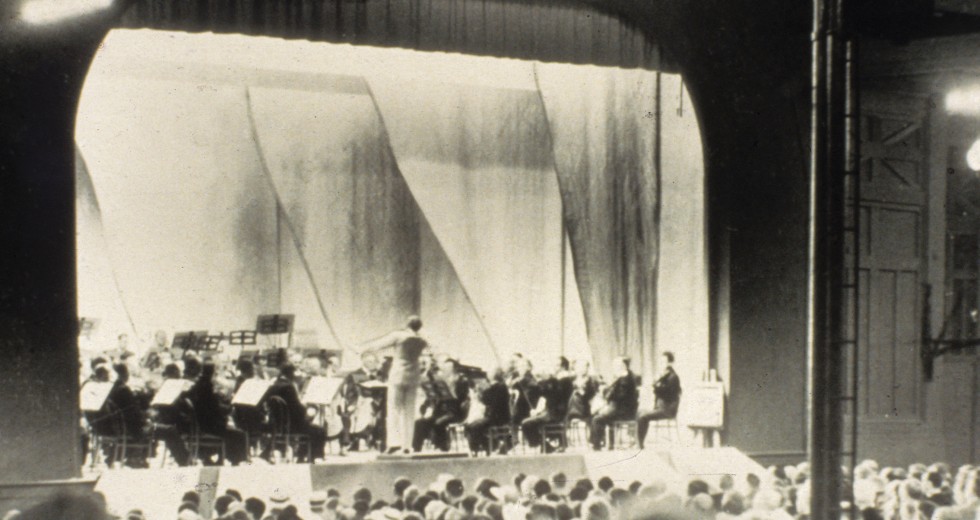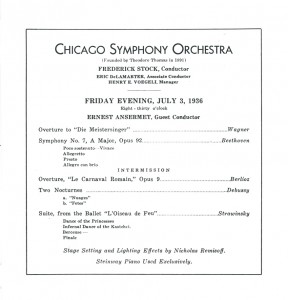
On July 3, 1936, Ernest Ansermet and the Chicago Symphony Orchestra inaugurated the first season of the Ravinia Festival* with a program that included Wagner’s Prelude to Die Meistersinger von Nürnberg, Beethoven’s Seventh Symphony, Berlioz’s Roman Carnival Overture, Clouds and Festivals from Debussy’s Nocturnes, and Stravinsky’s Suite from The Firebird.
“Three days ago the last seat in the pavilion was sold. The audience was socially brilliant and musically responsive, so that a full-length Beethoven symphony and the most sonorous of the preludes which Wagner wrote for any of his music-dramas evoked a veritable tumult of applause,” wrote Glenn Dillard Gunn in the Herald & Examiner following that first concert. “For the next five weeks the Chicago Symphony will continue the season begun last night, playing on Thursday, Friday, Saturday, and Sunday evenings and offering programs quite as serious as those presented in Orchestra Hall during the winter season.”
Several notable conductors made their Chicago Symphony Orchestra debuts at the Ravinia Festival, including future music directors Riccardo Muti, Georg Solti, Jean Martinon, Fritz Reiner, and Artur Rodzinski; future festival music directors James Conlon, Christoph Eschenbach, James Levine, and Seiji Ozawa; and prominent guest conductors Sir Thomas Beecham, Leonard Bernstein, Josef Krips, Erich Leinsdorf, Kurt Masur, Pierre Monteux, Eugene Ormandy, George Szell, and Michael Tilson Thomas.
“I look around at the beauty of the park, the acoustics and proportion of the Pavilion . . . and the Chicago Symphony Orchestra and Chorus in residence,” commented James Levine in the 1985 book Ravinia: The Festival at Its Half Century. “Look at how these people work during the Festival weeks—putting on performances of difficult music under extreme weather conditions sufficiently well to be worthy of recording, finishing one concert and getting up the next morning to rehearse for another. . . . Most of the people around Ravinia seem to find a rejuvenation synonymous with summer from the change of pace, the change of style, the challenge of new repertoire, and the opportunity to work from a different vantage point. It’s that kind of thinking, that buoyant spirit, which has been prevalent throughout the unique history of Ravinia. And it’s that spirit which makes Ravinia truly magical!”
*Ravinia Park had opened on August 15, 1904, and Frederick Stock and the Orchestra first performed at the park’s theater on November 20, 1905. The Orchestra appeared there semiregularly through August 1931, after which the park was closed for most of the Great Depression.
Image above: Ernest Ansermet and the Orchestra onstage at the Ravinia Festival on July 3, 1936 (Ravinia Festival photo)
This article also appears here.
